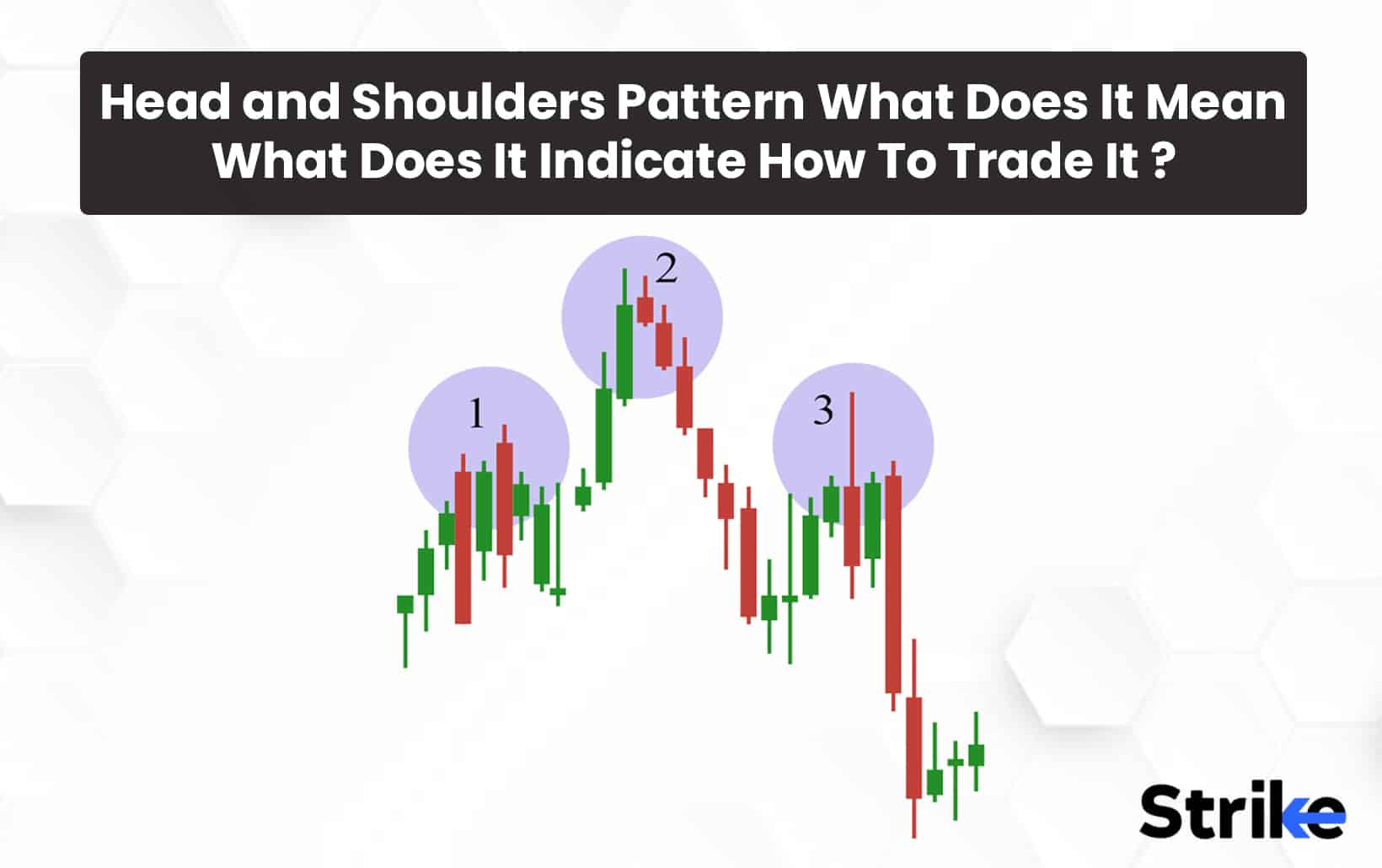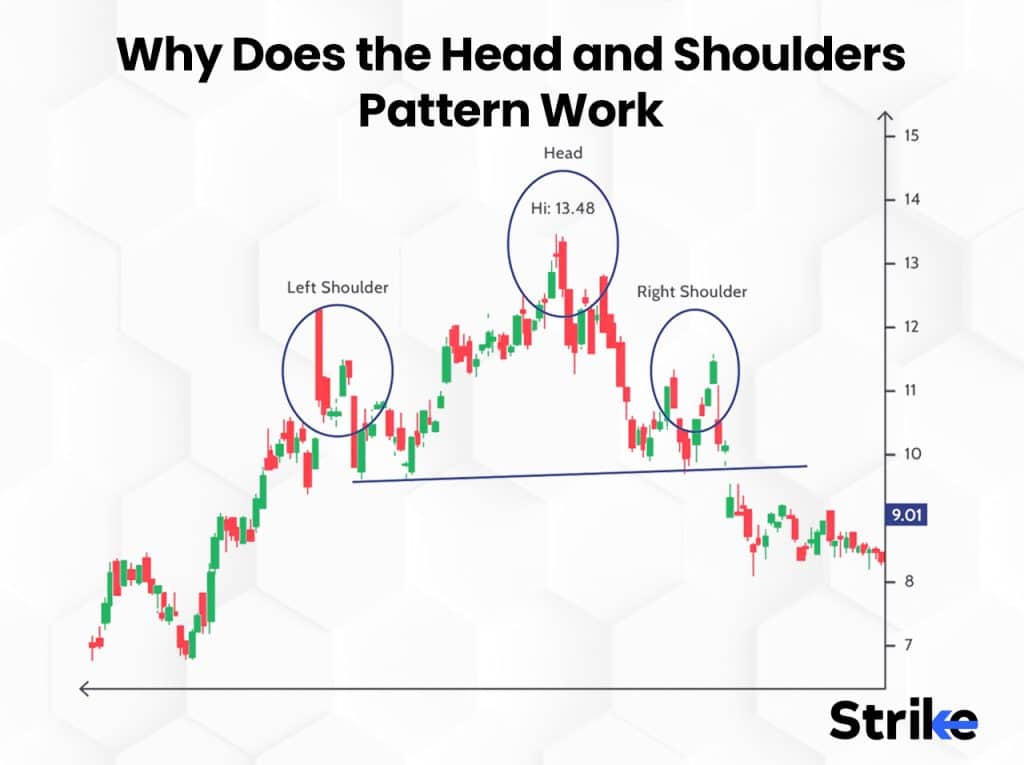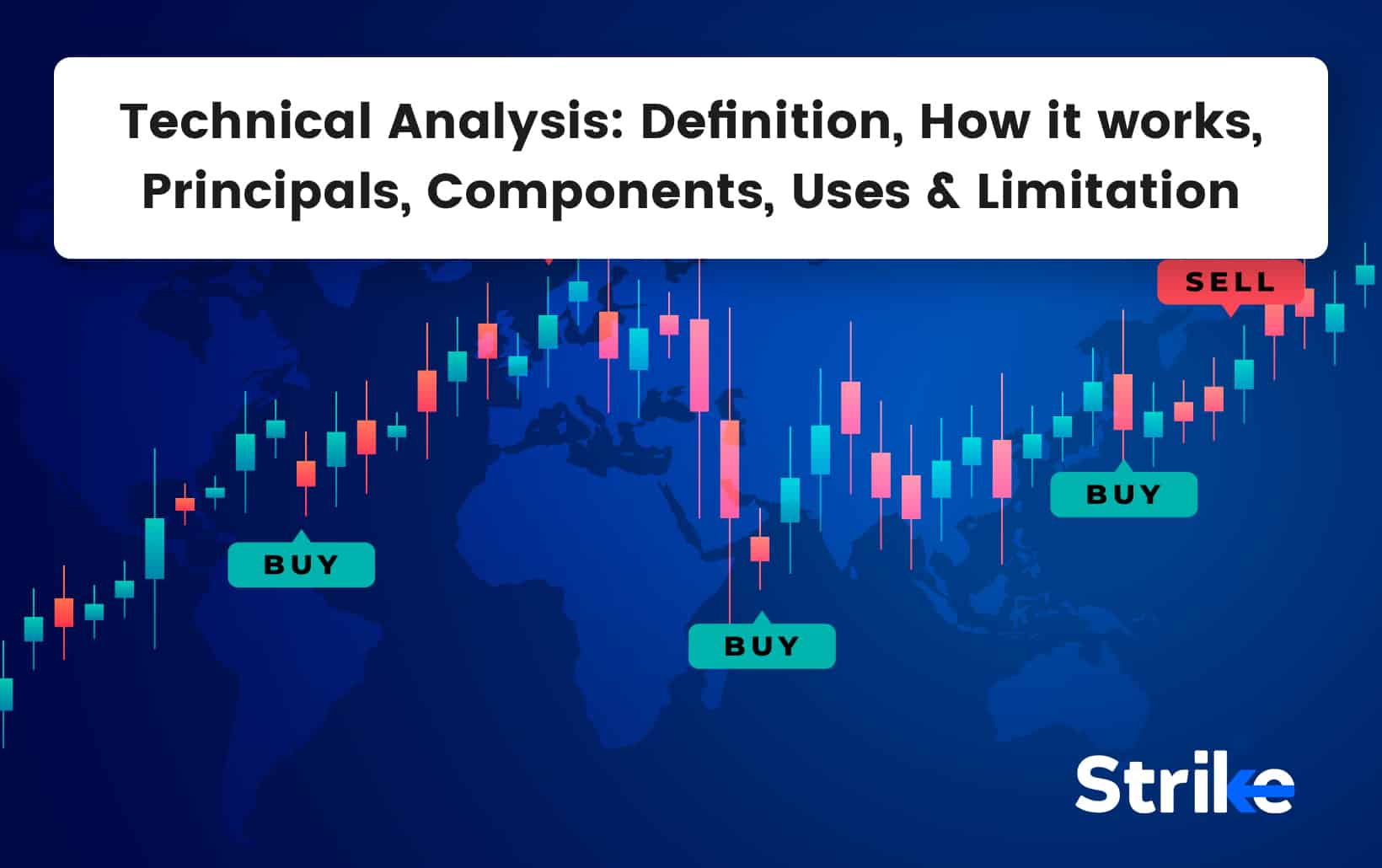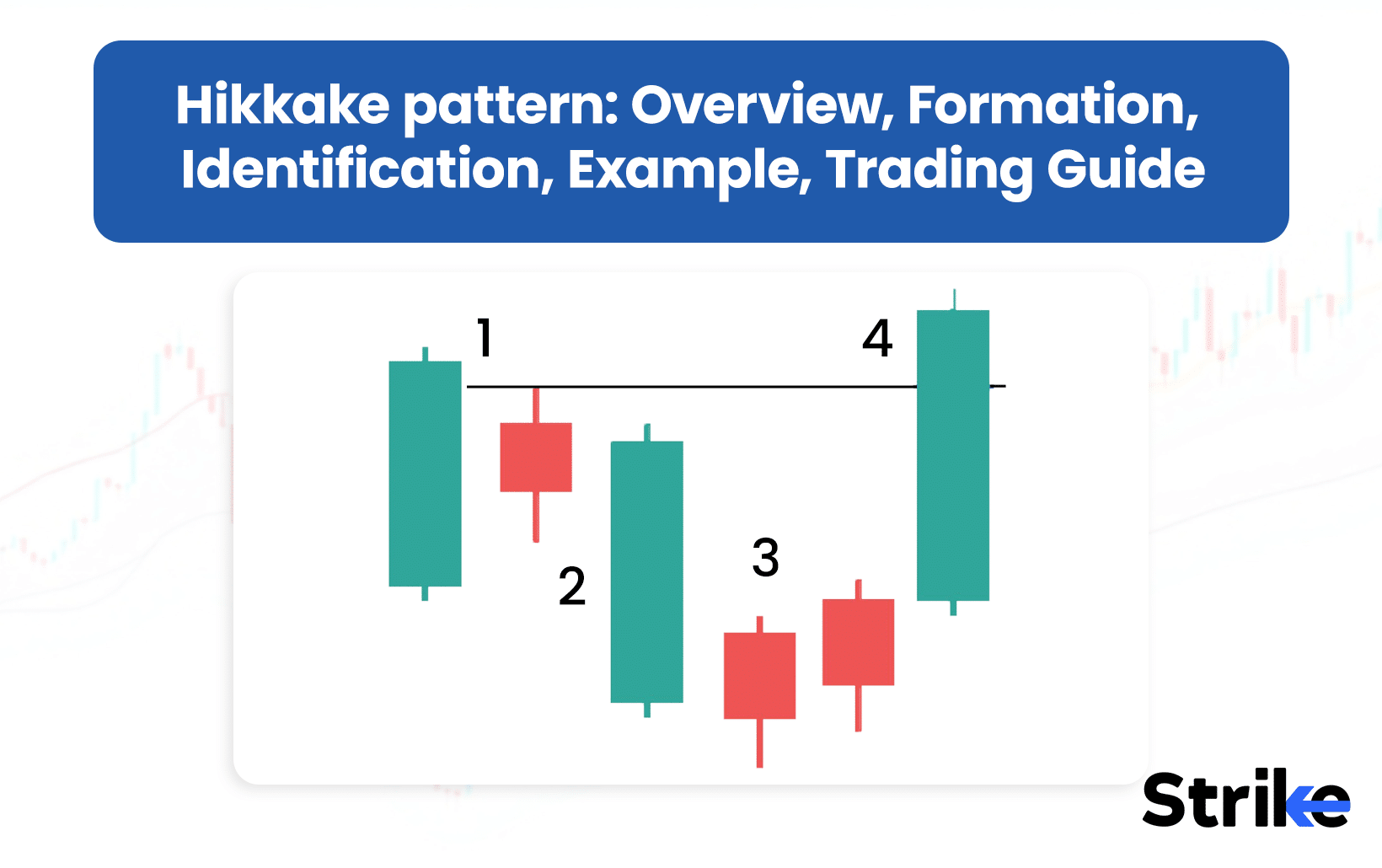
The head and shoulders pattern is a specific chart formation that predicts a bullish to bearish trend reversal. The head and shoulders pattern is considered as one of the most reliable trend reversal patterns. It appears as a baseline with three consecutive peaks, where the outside two are close in height and the middle is the highest. The head and shoulders chart is said to depict a bullish to bearish trend reversal and signals that an upward trend is nearing its end.
The pattern forms when a stock’s price rises to a peak and then declines back to the base of the prior up-move. The price then rises above the previous peak to form the “head” and then declines back to the original base. The stock price finally peaks again above the level of the first peak of the formation before falling back down. The pattern indicates that the new downward trend will likely continue until the right shoulder is broken, where prices move higher than the prices at the right peak.
The head and shoulders pattern is seen as a warning sign for traders and investors who were previously bullish on an asset. It can also indicate that it will be an appropriate time to consider selling or shorting the asset, or to close long positions. A trader should follow main steps to trade head and shoulders patterns, such as identifying the pattern, determining the neckline, confirming the pattern, measuring the price target, entering into the short position, managing risk etc.
What Does Head and Shoulders in Technical Analysis Mean?
The term “head and shoulders” in technical analysis refers to a specific chart pattern that is used to predict trend reversals in price movements. The “head and shoulders” pattern consists of three peaks or highs, with the middle peak being the highest and called ‘’head’’, while the other peaks are lower and referred to as ‘’shoulders’’. These peaks are formed by the price action of the security, and they are usually connected by a trendline known as the ‘’neckline”.
The head and shoulder pattern is formed after an uptrend in the price of an asset and indicates a potential trend reversal to a downtrend. It suggests that the buyers are losing control and the sellers are taking over, leading to a downward movement in price. The technical analysis chart pattern is considered complete when the price breaks below the “neckline”, which is a support level that connects the lows of the two concepts. This breakdown below the neckline confirms the reversal and provides a bearish signal to traders.
The projected price target for the downward move is often estimated by measuring the distance from the head to the neckline and extending it below the neckline. The pattern is considered bearish and suggests a potential reversal from an uptrend to a downtrend. Traders look for this pattern as a sign that the buying pressure is weakening and that a shift towards selling pressure will occur. Traders set a price target for the potential decline based on the height of the pattern once the head and shoulders pattern is confirmed. This is done by measuring the distance from the neckline to the top of the head and projecting at a distance downtrend from the neckline break.
What Does Head and Shoulders Pattern Indicate?
The head and shoulders pattern is considered a bearish pattern when it occurs after an uptrend and a bullish pattern when it occurs after a downtrend. The pattern indicates a reversal of an uptrend when the head and shoulders pattern forms after a sustained uptrend. It suggests a reversal from bullish to bearish. The pattern signifies that buying pressure is weakening and sellers will take control, leading to a downward trend.
The head and shoulders chart pattern will occur after a downtrend, indicating a reversal from bearish to bullish in rare cases. This pattern is also known as an inverse head and shoulders pattern. It signifies that selling pressure is diminishing and buyers will regain control, leading to an upward trend.
The formation of the head and shoulders pattern reflects a shift in market sentiment. It indicates that the market participants who were driving the previous trend are losing momentum, and the opposing group is gaining strength. This shift in sentiment can provide an opportunity for traders to enter new positions or adjust existing ones. The pattern also provides a price target for the potential trend reversal. The traders measure the distance from the head to the neckline and project it downward or upward from the neckline breakout point after the neckline breaks. The projected distance provides an estimate of the move after pattern confirmation.
The left shoulder in the head and shoulders pattern refers to the first peak on the left side of the pattern, before the central peak. This left shoulder is usually at a lower level than the head and serves as an initial indication of a potential reversal. The importance of the left shoulder lies in its positioning relative to the head and the subsequent right shoulder. The pattern suggests that buyers were initially in control, then the market rallied to create the head, and finally a failed attempt to reach new highs resulted in the formation of the right shoulder. Traders look for the break of the neckline as a signal to enter short positions and anticipate a downtrend continuation.
The head in the head and shoulders pattern is referred to as the most prominent peak in the pattern. It is located between the left shoulder and the right shoulder and represents a failed attempt by buyers to push the price higher. The head is higher than the shoulders, creating a characteristic visual pattern resembling a head with two shoulders on either side. The importance of the head in the head and shoulders pattern lies in its role as a turning point in the price trend. The price declines and breaks below a neckline, which is a support line connecting the lows of the left shoulder and the right shoulder after the formation of the head. This break of the neckline is considered a bearish signal, signaling that selling pressure has overwhelmed buying pressure and a downward trend will follow.
The right shoulder in the head and shoulders pattern refers to the second peak on the right side of the pattern, following the central peak and preceding a reversal. It is similar in height to the left shoulder and lower than the head. The formation of the right shoulder indicates a failed attempt by buyers to push the price higher after the initial decline from the head. It represents a period of consolidation or temporary recovery before the final decline that confirms the reversal. Traders observe the right shoulder to analyze the symmetry and proportionality of the pattern. The right shoulder is significant in that it helps validate the head and shoulders pattern when it forms below the neckline. It confirms the completion of the pattern and suggests a transition from an uptrend to a downtrend when the price breaks below the neckline, providing an opportunity for traders to enter short positions.
Traders and analysts use the head and shoulders pattern to set price targets or determine stop-loss levels. The height of the pattern can be measured and projected downward from the breakout point to estimate a target price for the reversal.
How to Place the Neckline?
Identifying the peaks in the price chart is an important step in placing the neckline in a head and shoulder pattern. Look for three peaks in a price chart. The peak should be relatively symmetrical in height and resemble the shape of a head and shoulders. Locate the lows between each peak. These are the points where the price temporarily pulls back before forming the next peak. The trough should also be relatively symmetrical in height. The neckline should be horizontal or slope slightly upward. Ensure that the pattern follows the guidelines of a head and shoulders formation. The middle peak should be higher than the two shoulders. The neckline should not intersect with any of the peaks. The pattern should have a clear and recognisable shape. It’s important to note that the placement of the neckline is somewhat subjective and will vary depending on the trader’s interpretation and the timeframe being analysed.
How Does the Signal Confirm the Trade?
The confirmation of a trade based on the head and shoulders pattern occurs when the price breaks below the neckline, which is a trendline connecting the lows of the two shoulders. The head and shoulders pattern is recognised when the price forms three peaks, with the middle peak being the highest. The pattern indicates that the uptrend is losing strength and a potential reversal is coming. The neckline acts as a support level for the pattern.
The confirmation of the pattern occurs when the price breaks below the neckline. This is considered a significant event as it suggests that selling pressure has overcome buying pressure and that the pattern is to follow through. The volume plays a crucial role in confirming the validity of the pattern. Traders look for an increase in trading volume when the price breaks. The higher volume shows greater conviction and participation from traders, strengthening the signal. Traders should consider using additional indicators and analysis techniques to confirm their trades and manage risk effectively.
How to Trade Using the Head and Shoulders Pattern?
Trading using the head and shoulders pattern includes identifying the pattern on a price chart and using it to make trading decisions. The head and shoulder pattern is a technical analysis trade pattern that can indicate a potential trend reversal. There are mainly three major steps to trade using the head and shoulders pattern.
1. Place the neckline
The neckline is a trendline that connects the lows between the two shoulders. It acts as a support level for the price during the formation of the pattern. It confirms the pattern and shows a potential bearish trend reversal once the neckline is ruptured to the downside. A trader should consider four major steps to place the neckline in a head and shoulders pattern. They are as given below.
Secondly, identify the left shoulder. Look for a peak in the price chart that is lower than the subsequent peak and is followed by a decline in price.
Thirdly, identify the head. Locate the highest peak in the pattern, which is the head.
Fourthly, identify the right shoulder. Look for another peak in the price chart that is lower than the head and is followed by a decline in price. This peak should be higher than the left shoulder.
Lastly, connect the lows. Draw a trendline that connects the lows between the left and the right shoulders. This trendline represents the neckline of the head and shoulder pattern.
The necklines are drawn as a straight line or have a slight upward or downward slope, depending on the characteristics of the pattern. It is important to note that the slope of the neckline will affect the pattern’s overall interpretation and potential price targets.
2. Setting your Stops
Setting stops is an essential aspect of trading the head and shoulders pattern. Stops help limit the potential losses and protect traders’ capital in case the trade moves against them. There are three major approaches for setting stops including stop above the right shoulder, stop above the head, and stop based on the pattern’s height. The placement of the stop loss order depends on the risk tolerance, trading strategy, and interpretation of the pattern. It is important to consider the pattern’s structure, the overall market condition, and any other supporting technical indicators or price action signals when determining the stop loss level.
3. Set your Profit Target
A profit target helps the traders determine the price level at which they want to take profits and close their trade. There are mainly three main approaches to setting a profit target when trading the head and shoulder pattern.
Firstly, measuring the pattern’s height. The common method is to measure the height of the pattern from the neckline to the top of the head.
Secondly, using a support level. Identify a significant support level that ranges with the target area based on other technical analysis tools or price action.
Lastly, using trailing stops. Traders can use a trailing stop to capture profit as the trade moves in their favour instead of setting a fixed profit target.
It is essential to remember that profit targets should be realistic and align with the overall trading strategy. Setting targets too close will result in premature exits while setting targets too far will lead to missed opportunities or increased risks.
Traders should wait for price action to move lower than the neckline after the peak of the right shoulder in the head and shoulders pattern. This is because a pattern will not develop at all or a partially developed pattern will not complete in the future.
Why Does the Head and Shoulders Pattern Work?
The patterns work based on the psychology of market participants and the dynamics of supply and demand. It is believed that the pattern reflects a shift in sentiment from bullishness to bearishness, leading to a potential trend reversal. The significance of the head and shoulders pattern lies in its implications for future price movements. Traders who identify this pattern interpret it as a sign of weakening bullish momentum and a potential shift towards a bearish trend. It is considered a confirmation of the pattern, once the price breaks below the neckline, traders will take short positions or sell their existing long positions, expecting further price declines.

The rationale behind the pattern’s effectiveness can be attributed to the psychology of market participants. The left shoulder and the subsequent decline show that the buying pressure is weakening. The subsequent rise to form the head represents a final attempt by buyers to push the price higher. The head’s peak falls to form the right shoulder when the price fails to exceed. It signals that sellers have gained control, resulting in a reversal of the previous uptrend. The head and shoulders pattern can be a useful tool for technical analysis, but it is important to note that patterns alone do not guarantee future price movements.
What are the Potential Risks of Head and Shoulders Pattern?
The head and shoulder pattern is widely recognised as a reliable trend reversal pattern, but it’s important to consider the potential risk associated with its interpretation. There are mainly six major potential risks, they are:
False Signals. The head and shoulders can sometimes produce false signals. It’s possible for a price movement to resemble a head and shoulders pattern, but the subsequent reversal will not occur as anticipated.
Ambiguous Formations. The pattern is a subjective pattern and can vary in shape and size. It can be challenging, sometimes, to identify a clear and well-defined pattern.
Whipsaws. The price will break the neckline but reverse back into the pattern in volatile or choppy markets, resulting in a false breakout known as a whipsaw.
Backtesting limitation. The pattern is identified reflectively by analysing historical price data. The pattern’s effectiveness will vary in different market conditions, and relying solely on historical data for pattern recognition will not always provide accurate prediction.
Risk of over-analysis. Traders will become overly fixated on identifying head and shoulders patterns, leading to excessive analysis and potential over-trading.
Market manipulation. Large traders or institutions will create head and shoulder patterns or manipulate prices to cause stock loss orders of other market participants in some cases.
It’s crucial to approach the head and shoulders pattern like any other technical analysis, with a balanced perspective and combine it with other forms of analysis to increase the probability of accurate predictions.
What is the Inverse Head and Shoulders Pattern?
The inverse head and shoulders pattern is a technical analysis pattern used to predict trend reversals in the financial market, particularly in stocks, currencies, and commodities. It is a mirror image of the regular head and shoulders pattern, which indicates a potential trend reversal from bullish to bearish. The inverse head and shoulders pattern consists of three distinct components: the left shoulder, the right shoulder, and the head.
The pattern is considered complete when a neckline, a trend line drawn across the peak of the two shoulders, is broken. The neckline acts as a resistance level, and once the price breaks above it, it indicates a potential bullish reversal. Traders and investors interpret the pattern as a sign that selling pressure is weakening and buying momentum will soon take over. Traders use the inverse head and shoulders pattern as a basis for setting price targets and determining entry and exit points.
What are the Indicators of Inverse Head and Shoulders Pattern?
The inverse head and shoulders pattern is a bullish reversal pattern that forms at the bottom of a downtrend. The key indicators to look for when identifying an inverse head and shoulders pattern are: A trader should look for three significant lows on a price chart and draw a line connecting the highs of two shoulders.
The volume tends to be higher during the formation of the left shoulder, lower during the head and higher again during the formation of the right shoulder. The two shoulders should be roughly equal in height and width and the breakout should be accompanied by an increase in volume, indicating a shift in sentiment. It is common for the price to retest the neckline from above after the breakout.
Does the Head and Shoulder Pattern have Three Peaks?
Yes, the head and shoulder pattern is a technical indicator with a chart pattern of three peaks. The pattern appears as a baseline with three peaks: the outside two are close in height, and the middle is the highest. The peaks at each end are the left and right shoulders, and the one in the middle is called the head. These peaks are formed by price movements, and they are connected by a neckline, which is a support level that connects the lows between the peaks.
Is the Head and Shoulders Pattern the Most Reliable Trend Reversal Pattern?
Yes, the head and shoulders pattern is widely regarded as one of the most reliable trend reversal patterns in technical analysis. It is highly recognised among traders and analysts for its potential to signal a shift in the prevailing trends. The pattern’s reliability stems from its distinct shape and the psychology it represents. The completion of the pattern occurs when the price breaks below the neckline, indicating a potential reversal from an uptrend to a downtrend. This breakdown is considered a strong self-signal for traders.
Does Inverse Head and Shoulders Pattern the Most Reliable Trend Reversal Pattern?
Yes, the inverse head and shoulders pattern is considered one of the more reliable trend reversal patterns in technical analysis. It is essentially the bullish counterpart to the regular head and shoulders pattern. The inverse head and shoulders pattern consists of three laws or troughs, with the middle trough being the lowest and called the “head”, while the other two troughs are higher and referred to as the “shoulders”. Traders consider the inverse head and shoulders pattern reliable due to its symmetry and psychology behind it.
Is the Neckline Important Indicator?
Yes, the neckline is an important indicator of the head and shoulders pattern. It serves as a key level of support or resistance and plays a significant role in confirming the pattern. The neckline is a trendline that connects the lows of the two shoulders in a head and shoulders pattern. It acts as a horizontal or sloping line that represents a level where the price has struggled to break through in the past. It is considered a confirmation of the pattern and signals a potential reversal in the price trend when the price breaks below the neckline. The significance of the neckline lies in its ability to validate the pattern.




![85 Common Stock Market Terminologies for Dummies [Updated List for 2025] 10 85 Common Stock Market Terminologies for Dummies [Updated List for 2025]](https://www.strike.money/wp-content/uploads/2025/04/Popular-Stock-Market-Terms-for-Beginners-Banner.png)











No Comments Yet.